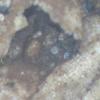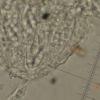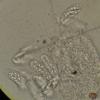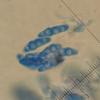
15-12-2025 15:48
 Danny Newman
Danny Newman
Melanospora cf. lagenaria on old, rotting, fallen

15-12-2025 15:54
 Johan Boonefaes
Johan Boonefaes
Unknown anamorph found on the ground in coastal sa

15-12-2025 21:11
 Hardware Tony
Hardware Tony
Small clavate hairs, negative croziers and IKI bb

15-12-2025 07:09
 Danny Newman
Danny Newman
indet. Rutstroemiaceae sp. on unk. fallen leavesMc

15-12-2025 07:05
 Danny Newman
Danny Newman
Pseudosclerococcum golindoi (det: Zotto)near Cosb

15-12-2025 11:49
 Danny Newman
Danny Newman
ITS sequences from the following two collections B

15-12-2025 12:34
 Danny Newman
Danny Newman
indet. Rhytismataceae on oak leafnear Purchase Roa

09-12-2025 12:06
 Andgelo Mombert
Andgelo Mombert
Bonjour,Je recherche l'article concernant Hypobryo
Acanthostigmella
Eduard Osieck,
23-04-2015 20:19
Minute hyaline perithecia (0.05-0.06 mm) with hyaline setae (20-23 um).
Bitunicate asci (30-40 x 10 mu) with 3-septate hyaline spores with big guttules: 13-16 x 4-5 um. One median cell larger than the other.
Substrate: Lophiotrema cf. neohysterioides (= curreyi) and on bark of Hedera.
I assume this belongs to the genus Acanthostigmella.
With the key included in the paper of Barr 1977 it easily keys out as A. pallida but this species has much smaller spores (7-10 X 2.5-3.5 um) and smaller ascii (20-25 x 10-11 um).
Six years later (Barr & Rogerson 1983) described A. brevispina (also known as Tubeufia brevispina) as a new species with spores which are more in agreement with my find: 14-18 x 4-5 um. However this species has larger ascii (50-60 mu) and also much larger perithecia (diameter 0.13-0.18 mm).
Belongs this find to Acanthostigmella? And what about the species?
I hope somebody has some knowledge about this species although the Ascofrance database does not contain any finds.
Eduard
Björn Wergen,
01-05-2015 00:01

Re : Acanthostigmella
Hi Eduard,
do you still have a piece of this collection for studying?
regards,
björn
do you still have a piece of this collection for studying?
regards,
björn
Eduard Osieck,
01-05-2015 15:23
Re: Acanthostigmella
Hi Björn,
Yes the material is still in good condition, the perithecia have even multiplied over a larger area of the (not dead) Hedera twig. Apparently the ascomata become pale brownish after some time. Some ascomata are larger than indicated, up to 0,10 mm, but still smaller than in Barr's description of A. brevispina. However, I have found also much longer ascii, up to 64-75 um. They seem to stretch outside the perithecia. So it might very well be this species or a yet undescribed European counterpart. Particularly striking is the enlarged median cell ("2e loge sporale nettement renflee", quoted from Holm 1957).
I will send you the material today, than we get at least splendid photos :)
EDuard
Yes the material is still in good condition, the perithecia have even multiplied over a larger area of the (not dead) Hedera twig. Apparently the ascomata become pale brownish after some time. Some ascomata are larger than indicated, up to 0,10 mm, but still smaller than in Barr's description of A. brevispina. However, I have found also much longer ascii, up to 64-75 um. They seem to stretch outside the perithecia. So it might very well be this species or a yet undescribed European counterpart. Particularly striking is the enlarged median cell ("2e loge sporale nettement renflee", quoted from Holm 1957).
I will send you the material today, than we get at least splendid photos :)
EDuard





